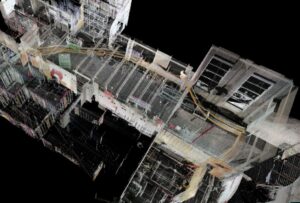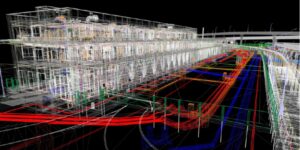In a reversal of the infrastructure sector’s initial general hesitance to switch from two-dimensional drawings to BIM, the last couple of years have seen a growing client appetite for taking BIM to the next level through data- and analytics-driven digital twins, according to Cory Dippold, a vice president in Mott MacDonald’s New York office who heads the company’s new Digital Twin solutions group in North America. “We’re pushing against an open door,” he says.
What is a Digital Twin?
Digital twins are data-animated 3D models of real-world assets. They generate value over the lifecycle of the asset, from design and construction through operations and maintenance, by generating insights that inform decisions to improve outcomes in the physical world.
What distinguishes a digital twin from any other model is its near-live link to its real-world twin. The digital entity is continually updated with data federated from a variety of sources—sensors, SCADA systems, customer billings, images, drone or laser surveys, GPS, manufacturers’ data and others—so that it always offers a realistic representation of the asset (or process or system) as it evolves through time.
The twinning sets up a feedback loop in which information flows from the physical asset to the digital version. There data is cleaned, structured and analyzed to generate insights, which lead to decisions that travel back to the physical asset in the form of interventions. The interventions lead to outcomes, which generate data, and the cycle begins again.
Project types that are especially well positioned to benefit from having a digital twin share some common characteristics, says Dippold. They are often logistically complicated, they may generate high volumes of real-time data, their shut-downs could be operationally difficult and physical access may be limited, where downtime carries significant costs—common traits in the infrastructure sector. Waiting to react can prove expensive compared with proactive interventions.

[A digital twin is continually updated with data from a variety of sources, including sensors, SCADA systems, customer billings, images, drone or laser surveys, GPS, manufacturers’ data and others.]
Guiding Principles for Digital Twin Use
According to the Gemini Principles, a digital twin must first have a clear purpose: It must be used to deliver genuine public benefit in perpetuity; it must enable value creation and performance improvement; and it must provide determinable insight into the built environment. Second, it must be trustworthy: It must enable security and be secure in itself; it must be as open as possible and it must be built on data of an appropriate quality. And third, it must function effectively: It must be based on a standard connected environment; it must have clear ownership, governance and regulation; and it must be able to adapt as technology and society evolve. Figures from Deloitte and the UK Office of National Statistics suggest that greater data sharing could release an additional £7 billion per year of benefits across the UK’s infrastructure sectors, equivalent to 25% of total spend. The Gemini Principles aim to provide an industrywide foundation for realizing that value.

[What distinguishes a digital twin from any other model is its near-live link to its real-world twin.]
How to Unlock the Value of Digital Twin Technology
Unlocking value for clients entails a choice as to which of two types of digital twin will best serve a given project. The first type is purpose-built to address specific issues in an existing asset. This twin does not need to represent every part, piece and component; rather, it needs to model the elements that are engaged in the problem and to incorporate the datasets that are pertinent to solving it. The second type is a comprehensive representation of an asset from first principles. Its developers may not be able to anticipate all of the ways the entity will be used to optimize a project’s construction, management and maintenance, but they design the model from the get-go to allow it to contribute to the full gamut of possibilities.
Even though industry interest in the potential of digital twin technology is increasing, some challenges to broad uptake remain. “One of the early obstacles for all of us will be to prove the business case: that the digital twin can provide more value than the cost of creating it,” says Dippold. Although, he adds, new service delivery models will likely lower the barrier. For example, rather than the transactional model in which clients pay upfront for the development of a digital twin as a product, structuring the relationship as a subscription to a service could offer a low-risk alternative. In this case, the provider creates a twin and runs analytics to which the client buys access on a predictable cost model.
And while examples that have paid for themselves dollar-for-dollar in construction economies or operational savings may take a while to find, a reduced risk of catastrophic failure, improved workforce safety or information taken out of file cabinets and structured to become searchable, functional and actionable all represent significant forms of value beyond a dollar-for-dollar equivalence. As infrastructure projects contemplate the adoption of a digital twin, “the name of the game is not necessarily money,” says Dippold. “It’s value.”
